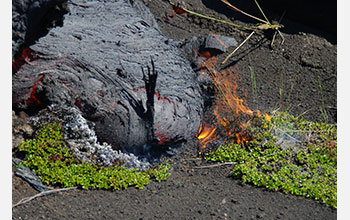Multimedia Gallery
Tolbachik volcano in central Kamchatka, Russia (Image 6)
Brush ignites on the surface of the Tolbachik volcano in central Kamchatka, Russia.
More about this image
The massive eruption of Tolbachik began with little warning on Nov. 27, 2012, after 36 years of quiescence. Within two days of the eruption onset, the lava flows had already traveled nearly 10 km, covering an area of ~14 km2. The eruption has formed a series of cinder cones that feed lava flows, which at the time of this writing extend for nearly 20 km over the barren slopes of the volcano down into snow-covered forests.
Pavel Izbekov, a research associate at the Alaska Volcano Observatory, University of Alaska Fairbanks, has received grants from the National Science Foundation (NSF) to study the volcano including a RAPID (Response) grant to support systematic sampling and analysis of the eruptive products of Tolbachik. A suite of samples collected was analyzed for whole rock chemistry and composition of glasses. Results show that Tolbachik erupted what appears to be nearly aphyric high-Al basalts, with their composition gradually becoming more primitive in the course of the eruption. The magmas contain rare megacrysts of anorthite, which bear some similarity to the magmas erupted at the end of the previous eruption (1975-76).
Izbekov's research also focused on the interaction of lava with snow and ice. Gaining a more quantitative understanding of how lava flows interact with snow and ice is critical for assessing hazards at snow and ice-covered volcanoes and for improving the ability to recognize ancient deposits formed by lava-snow interactions.
This research was supported by NSF grants OISE 05-30278, IIA 04-29155 and EAR 13-21636. (Date of Image: 2003) [Image 6 of 7 related images. See Image 7.]
Credit: Pavel Izbekov, Geophysical Institute, University of Alaska Fairbanks
Images and other media in the National Science Foundation Multimedia Gallery are available for use in print and electronic material by NSF employees, members of the media, university staff, teachers and the general public. All media in the gallery are intended for personal, educational and nonprofit/non-commercial use only.
Images credited to the National Science Foundation, a federal agency, are in the public domain. The images were created by employees of the United States Government as part of their official duties or prepared by contractors as "works for hire" for NSF. You may freely use NSF-credited images and, at your discretion, credit NSF with a "Courtesy: National Science Foundation" notation.
Additional information about general usage can be found in Conditions.
Also Available:
Download the high-resolution JPG version of the image. (971 KB)
Use your mouse to right-click (Mac users may need to Ctrl-click) the link above and choose the option that will save the file or target to your computer.

